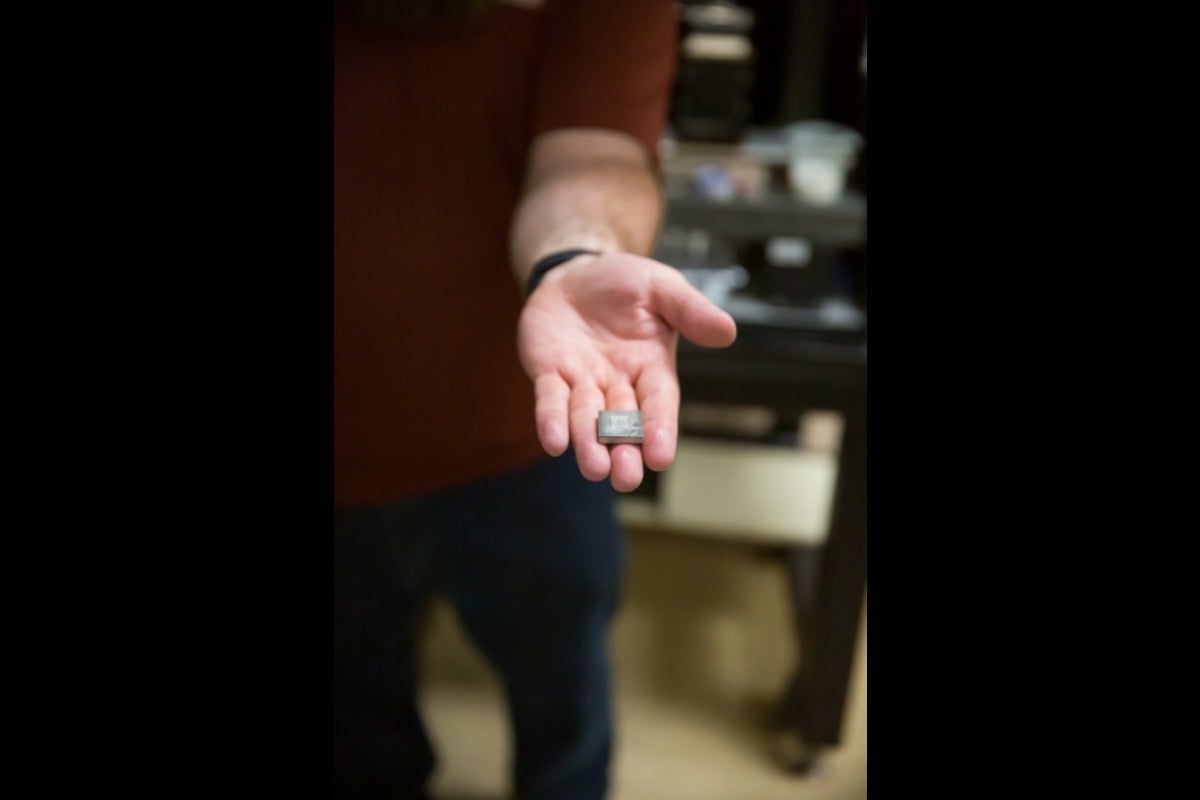Investigating the mechanics of materials at the smallest scale

Christian Hoover, an assistant professor in the School of Sustainable Engineering and the Built Environment in the Ira A. Fulton Schools of Engineering at ASU, will expand his research into glassy, metallic-organic frameworks in the next five years with funding from a National Science Foundation CAREER Award. Photo by Monica Williams/ASU
When looking to determine the strength of a material or understand why it acts the way it does, Christian Hoover says you may want to start small.
“I got my PhD at Northwestern University working in an area called cohesive fracture mechanics with a focus on the so-called size effect,” says Hoover. “It is a way of understanding that small structures made of certain materials have a higher strength than larger structures made of the same materials, and it’s important to understand that phenomenon when you’re designing large-scale projects from those materials.”
His path then led him to the Massachusetts Institute of Technology for his postdoctoral work, where he studied the mechanics of materials on the nano and micro scales. He pushed to understand the properties of materials and has published works on the mechanics of glass, bitumen, cement, polymers and clay minerals since arriving to Arizona State University to teach civil engineering in the Ira A. Fulton Schools of Engineering.
Hoover, an assistant professor in the School of Sustainable Engineering and the Built Environment, one of the seven Fulton Schools, says he will be applying the concepts he learned from his doctoral and postdoctoral work as he moves forward with a five-year research project focusing on glassy, metallic-organic frameworks, or gMOFs.
The project is supported by Hoover’s 2022 National Science Foundation Faculty Early Career Development Program Award, or CAREER Award, which comes with $600,000 in funding.
The CAREER Award program supports university faculty members who are early in their careers and show leadership potential as researchers and educators. They are selected to serve as role models in their academic departments and to help advance research in their field.
“Understanding the origins of the behaviors of these materials is the first step in being able to exploit these materials for specific applications,” says Hoover.
MOFs are porous hybrid materials that start out as crystals, or cMOFs, reinforced with an additional organic structure, and are highly sought-after for several applications. They can be created with little negative impact on the environment, and with tailored small-scale features and optimized structures to achieve a variety of unique optical, electrical and magnetic behaviors.
Perhaps one of their biggest appeals is their large absorptive surface areas, brought on by their high porosities, which can be used for applications in carbon dioxide capture, separation and storage.
However, there are many mechanical drawbacks of cMOFs that inhibit their widespread use. For example, to be used in such industrial carbon capture and sequestration applications as an adsorbent medium, the cMOFs must be able to withstand the high pressures that arise from continuous CO2 flow. In testing, pieces of cMOFs have been shown to collapse quite easily because the highly porous structure makes the cMOF very delicate and fragile. The fragility of cMOFs also inhibits them from being made into larger pieces.
A solution to the mechanical deficiencies in cMOFs is to create a gMOF system by melting and densifying the cMOF without destroying the organic structure. This is how gMOFs are made and why they offer the ability for designers to specify what porosity they would like in order to achieve a desired mechanical performance. A major advantage of gMOFs is that they are capable of being made in larger pieces in any shape, large enough for a variety of applications.
“You can think of them as a glass that is also reinforced with an organic structure as well,” says Hoover.
The major knowledge gap with gMOFs is that most of their mechanical behaviors are unknown. An Ashby plot, or behavior chart, enables materials scientists to track properties such as density or yield stress in materials and categorize them with like items. The behaviors of gMOFs that are known are mostly unique and overlap new and unexplored domains in these charts. Through his research, Hoover hopes to find out what causes these materials to behave so uniquely.
Hoover says receiving a CAREER Award is an honor because the NSF bases its decisions of who will receive the awards on the recommendations of prominent reviewers who are deeply entrenched in the mechanics research community.
“It means the people in your community deemed you and your ideas worthy enough to get this award,” says Hoover. “So it’s a huge honor.”
More Science and technology

ASU-led space telescope is ready to fly
The Star Planet Activity Research CubeSat, or SPARCS, a small space telescope that will monitor the flares and sunspot activity…

ASU at the heart of the state's revitalized microelectronics industry
A stronger local economy, more reliable technology, and a future where our computers and devices do the impossible: that’s the…

Breakthrough copper alloy achieves unprecedented high-temperature performance
A team of researchers from Arizona State University, the U.S. Army Research Laboratory, Lehigh University and Louisiana State…



